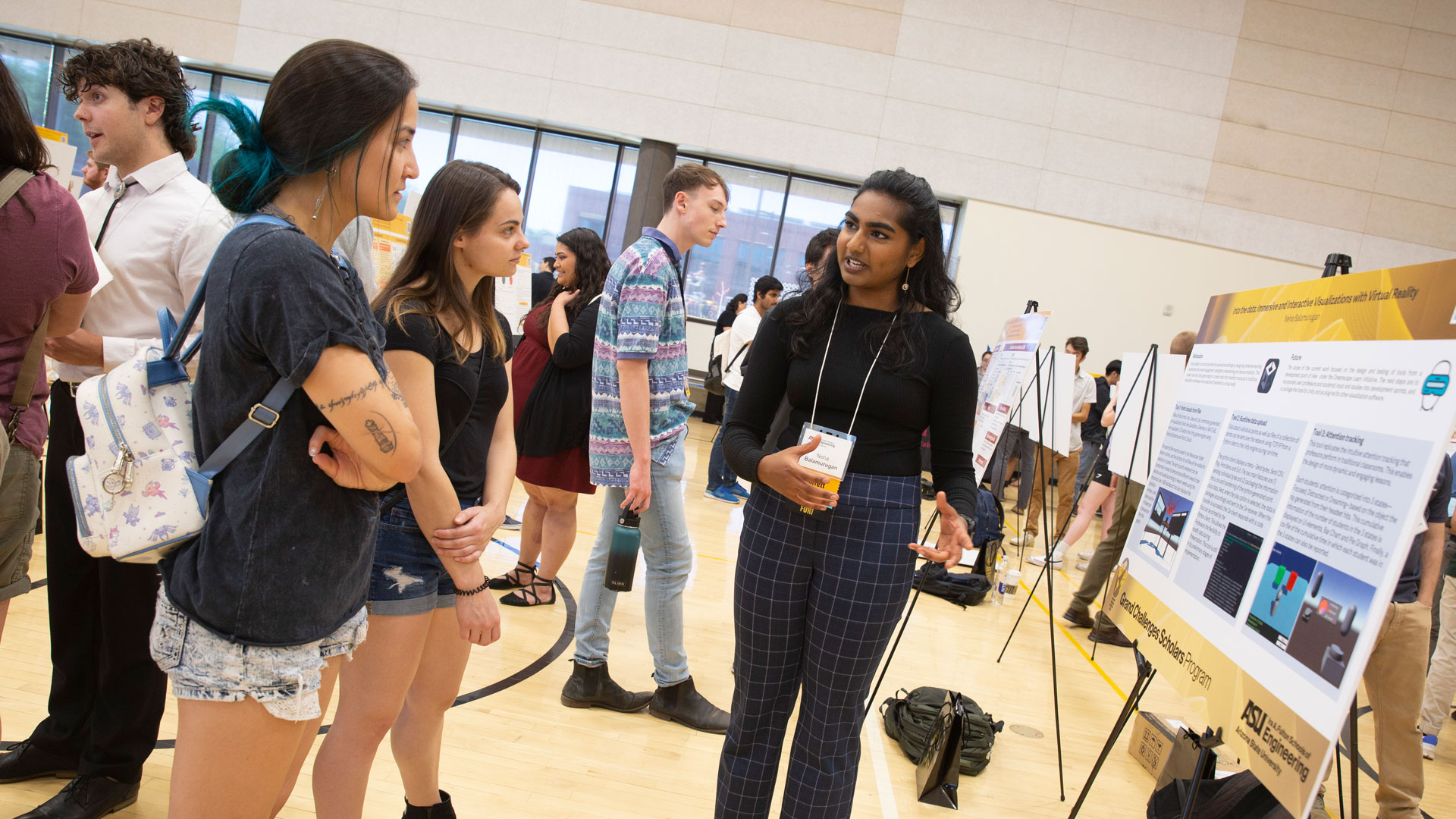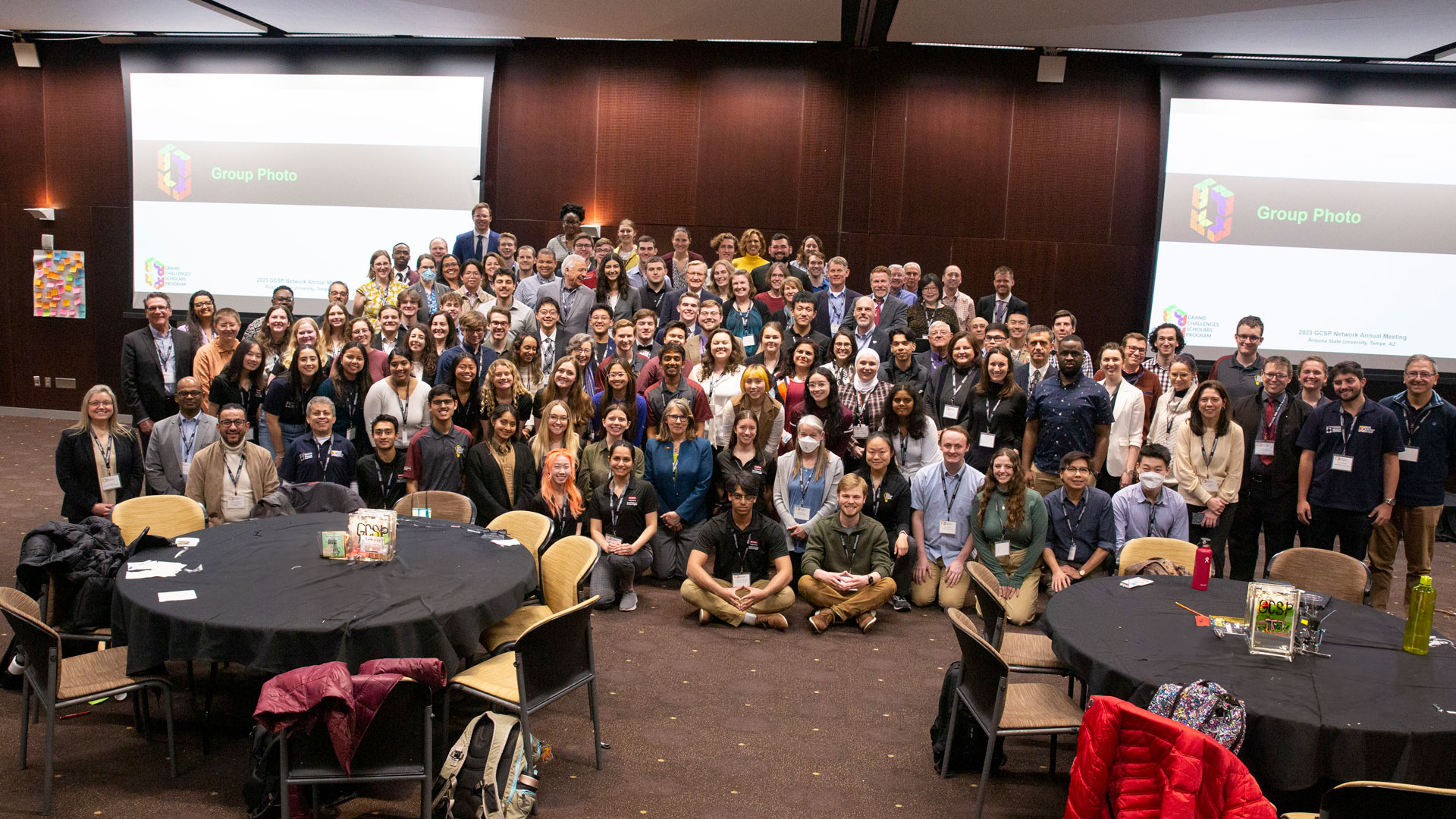
Global challenges generate stronger engineers

The Grand Challenges Scholars Program, known as GCSP, is an educational initiative to develop the next generation of engineering leaders equipped to address the world’s most pressing societal and technological challenges.
Undergraduate students who become Grand Challenges Scholars focus their education and research efforts on 14 key Grand Challenges that have been identified by the National Academy of Engineering, or NAE, as critical to the future well-being and sustainability of humanity. These challenges are divided into four focus areas: sustainability, health, security and joy of living.
In the Ira A. Fulton Schools of Engineering at Arizona State University, the Grand Challenges Scholars Program seeks to prepare tomorrow’s engineering leaders by combining an innovative curriculum and hands-on research experiences that merge academic disciplines while providing entrepreneurial, global and service learning opportunities.
Five competencies
Completion of GCSP is contingent on a student’s development of the five competencies established by the program, which give students the opportunity to engage their talent in research relating to their selected grand challenge, explore interdisciplinary coursework, hone their entrepreneurial mindset, gain an international perspective and give back to the community through service learning.
To fulfill the talent competency, Grand Challenges Scholars complete two semesters of mentored research or creative project experience related to their chosen Grand Challenges theme. This participation in mentored projects grants them hands-on experience and in-depth knowledge.
Jocelyne Espinoza, a junior biomedical engineering major in the Fulton Schools, is currently working as a research intern at Barrow Neurological Institute to complete her talent competency.
“The research project I’m doing there consists of redesigning a suction probe used in neurosurgery to include sensors that aid in the detection of destructive motions to cranial nerves,” Espinoza says. “I felt that this was an excellent opportunity to complete my talent competency by directly working in research and development alongside industry professionals.”
To design solutions for the complex challenges facing society today, Grand Challenges Scholars must recognize the multidisciplinary nature of engineering. Gaining an interdisciplinary perspective by discovering fields outside of engineering that complement their technical engineering skills prepares students to work where engineering overlaps with public policy, business, law, ethics, human behavior, risk, the arts and medicine.
Understanding the necessity of a viable business model for solution implementation is the center of the viable business or entrepreneurship competency. This allows scholars to learn how to translate invention into innovation and develop market ventures that scale to global solutions.
The multicultural or global competency requires students to develop an appreciation of different cultures and customs to ensure that proposed engineering solutions are accepted by the global community.
The fifth competency establishes that engineering solutions should primarily serve people and society, reflecting social consciousness. Students complete service learning to develop this awareness and use it as motivation to utilize their technical expertise to solve societal problems.
Solving problems for a greater future
One reason many students look to a career in engineering or other STEM fields is their desire to create a solution to a problem they’ve observed.
For Carol Lu, a junior double majoring in biomedical engineering and mathematics (statistics) at ASU, the problem she sought to solve was one she discovered due to her upbringing.
“Having been raised by my grandma for the first few years of my life and living among retirees, I witnessed many of the degenerative processes that come with aging and the costs associated with taking a dozen medicines a day or more intensive treatments every week,” Lu says. “I desired to improve their quality of life by improving their health — or even simply caring for them.”
Lu was not interested in becoming a doctor, nurse or any other occupation working on the front lines of health care, however. She admired her father’s work as a structural engineer. The balance the engineers must find between redundancy, to reduce the risk of potential devastation, and efficiency, to make the product commercially viable, appealed to her.
“I found the perfect marriage of these two realms in the Grand Challenge of engineering better medicines,” Lu says. “For me, this means personalized understanding of the patient, reducing the risk of severe complications through less invasive treatment methods, and really focusing on making it clinically feasible.”
Lu thinks precision medicine and targeted therapies are the future of treating acute diseases and other health issues.
“The goal of the magnetic microrobotics lab I am in is to make a tool that can less invasively deliver a therapy to the region of interest so that we might reduce the overall quantity of the therapy needed or operations performed,” she says.
Cameron Morgan, an environmental engineering senior, says that he has a few different reasons for joining GCSP and taking on the Grand Challenges.
“The biggest reason is my passion for developing technology focused on combating climate change,” Morgan says. “In eighth grade, I attended Al Gore’s Climate Reality Project Conference and learned about the dangers the climate crisis poses and how we will need to move forward.”
Since then, Morgan became motivated to major in environmental engineering and focus on research to help avert the climate crisis.
“I’ve conducted research in Germany on synthesizing catalysts for nitric oxide reduction to inert nitrogen, and my current work at ASU on developing enhanced polymers for direct carbon dioxide capture from air,” Morgan says. “I’ve found that by physically integrating a specific additive into a polymer designed for carbon dioxide capture, so far I can increase the carbon dioxide capture capacity by 50% and almost double the kinetics of carbon dioxide uptake.”
Expanding the GCSP community
With approximately 380 students currently taking part in GCSP in the Fulton Schools, those scholars encourage more students to join them on the path to being a Grand Challenges Scholar.
“I believe it is part of the purpose of GCSP’s very structure to let students tailor their portfolio to do what they’re interested in while giving them maybe that slightest extra push of motivation,” Lu says.
Access to many career-building and networking opportunities helps students grow as engineers and people.
“I would highly recommend GCSP to any incoming engineering student as I feel that it is a program and, most importantly, a community,” Espinoza says. “I am passionate about using my engineering skills to have a tangible impact on improving the quality of life within the community.”
The opportunity to participate in unique experiences that develop skills outside the engineering classroom and become a more well-rounded engineer is an extra perk of being part of GCSP.
“Those skills will make me a competitive graduate school applicant,” Morgan says. “I also joined to build connections and meet passionate, like-minded people all trying to solve some of the biggest challenges the world faces.”

Arizona State University became the first ever university to host the GCSP Network Annual Meeting in February. The event helped inspire students to think broadly about ways to expand and deepen their ability to help solve important worldwide challenges as part of GCSP. Photographer: Erika Gronek/ASU
Showcasing ASU to the GCSP Network
Last spring, ASU hosted the 2023 GCSP Network Annual Meeting in Tempe. The annual meeting is an opportunity for the international community of GCSP students, alumni, faculty, staff and supporters in the GCSP Network to come together. This year it was held in-person for the first time since 2019.
Over 150 attendees from more the 35 different institutions came to ASU for the event — the first time the meeting has been hosted by a university rather than at the National Academy of Engineering in Washington, D.C.
“The annual meeting allowed us to highlight ASU’s role as a leader in the GCSP Network,” says Amy Trowbridge, director of ASU’s Grand Challenges Scholars Program and an associate teaching professor in the Fulton Schools. “We were proud to host this event that facilitates connections among many different people in the GCSP Network community. It was a great opportunity for our ASU GCSP students to meet, connect with and learn from others engaged in GCSP at institutions from around the world.”
The GCSP Network Annual Meeting consisted of nearly 50% students among attendees, much higher than in prior years, creating an energetic event. The meeting enabled ASU students like Espinoza to make new connections.
“As students and future engineers, this meeting gave us an opportunity to share meaningful experiences with other like-minded individuals and network with industry professionals,” Espinoza says. “There was a variety of different workshops and helpful panels where we heard a lot of new perspectives from students, faculty, engineers and more that gave us insight into what we have in store in the future.”
ASU students who are interested in learning more about GCSP are invited to read more about the program and apply today.



































